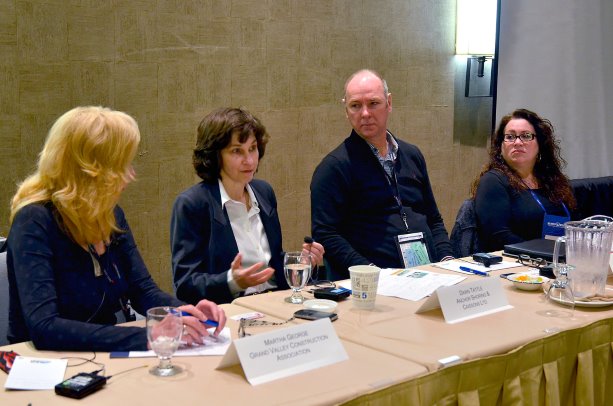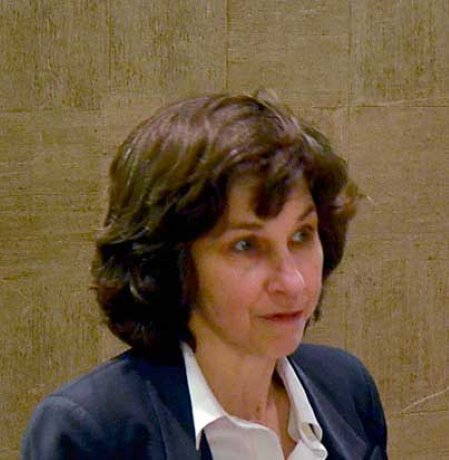As president of Anchor Shoring & Caissons Ltd. Dawn Tattle says a lot has changed in the industry for women since she became a partner in 1986 and eventually assumed her role in 1997.
"I think there’s been a lot of change in the industry in the time I’ve been in it, from originally when you couldn’t find work boots that were made for women or fit," she told members of the audience at a panel discussion on Women in Construction during the Ontario General Contractors Association’s recent Construction Symposium.
"I remember being kind of excluded from a few events because people were maybe worried that the comedian would be off colour in their jokes and I might be offended. I got by that because I told worse jokes and then they invited me."
Over the years Tattle says she took the approach of embracing every opportunity, regardless of the hurdles of a predominately male industry.
"I think one of the big secrets…is humour and having a thick skin," she explained. If you can fit in, in terms of just having conversations and not looking for people to be treating you in a different way, the situation goes a lot better."
Tattle was joined on the panel by Tammy Evans, a commercial real estate and construction lawyer and president of the Canadian Association of Women in Construction (CAWIC), Martha George, president of the Grand Valley Construction Association, and Harold Reinders, president and COO of Maple Reinders Constructors Ltd.
With women representing less than four per cent of those on the tools, and less than 12 per cent in the entire construction industry in Canada, the idea behind the session was to engage the panel and the audience to see how to improve and leverage this "untapped talent pool."
"Eleven per cent of women in construction is just a woefully low number and so it’s more of an opportunity that I see as a general contractor for us to change the way we’ve been thinking about women in construction," Reinders said.
"As a company, Maple, we view the role and we determine who’s going to fill the role by their capability and their skillset. I think as an industry we have to change the way we think. We have to forget about looking at people in terms of gender."
George shared a similar view.
"You hate it when it says, well we’ve got five men, now we have to have five women. You have to hire on the skills. To ever be the token woman on any panel, on any board, don’t get me started because you never want to be there as a woman. You want to be there because you’ve earned your spot," she said.
"If you look hard enough, you’re going to find women that are capable and skilled. If there not in this pond, look in another pond."
Tattle emphasized the importance of showcasing what a career in construction can bring.
"One of the big things is just even attracting good people into construction," she said. "Whether you’re a man or a woman I think that there is less attraction for the field. We need to really focus on the value that construction brings to the world."
Those on the panel were also quick to point out that more education and encouragement is needed for youth and that starts at home and at school. "Young people don’t have the same gender bias that older generations do," George said.
"It’s a problem that probably will solve itself in 15 years because a younger generation coming into the workforce has a much different attitude.
"But in the meantime, I think we need to have clear career paths and companies that do invest in women and their career path. The trend has been to push students into university and to disregard or put a skilled trade or even construction management as sort of a second tier," added Evans.
She outlined CAWIC’s plans to develop an action plan that will encourage and retain more women in the industry.
The association has embarked on a 36-month project, which was made possible through $249,000 in federal funding.
"We want concrete, measurable steps to take," she added. "We want to see exactly what’s going on."
After the panel discussion, audience members were separated into groups where they responded to questions about the needs of women in construction, the challenges they face and the role of employers.
Some of the results showed people need to be more open about women in construction and education at an early age could help change perceptions.
Seasonal work and uncommon hours were also mentioned as barriers women face, as they are often the primary caregivers for children.
Overall, changing perceptions and working together were predominant themes.
"I’m also hopeful…that the whole image of construction will change and is changing. It should be a first choice," added George.

From left, OGCA symposium Women in Construction panelists Martha George, president of the Grand Valley Construction Association, Dawn Tattle, president of Anchor Shoring & Caissons Ltd., Harold Reinders, president and COO, Maple Reinders Constructors Ltd., and Tammy Evans, commercial real estate and construction lawyer and the director of Canadian Association of Women in Construction (CAWIC). The panelists gathered to discuss the current state of women in construction and how best to encourage more interest in the industry.
Photo: Lindsey Cole"










Recent Comments
comments for this post are closed